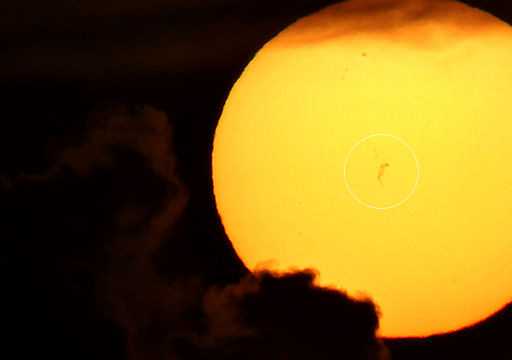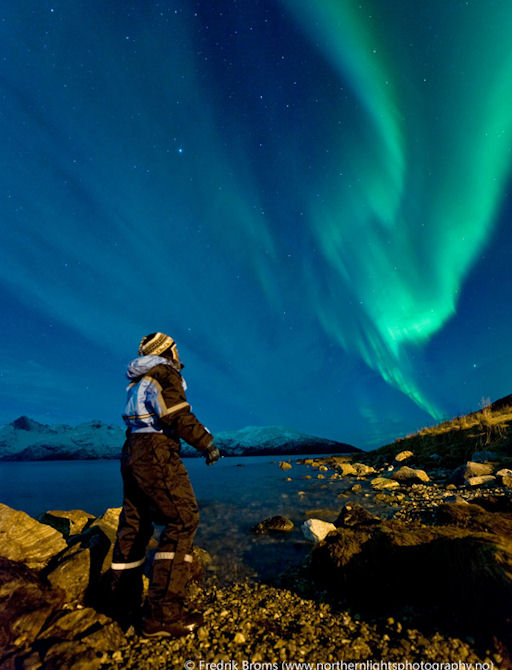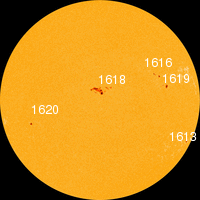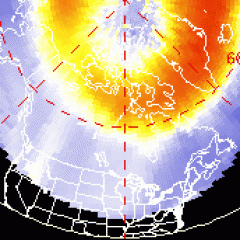CHANCE OF STORMS: NOAA forecasters estimate a 65% chance of polar geomagnetic storms on Nov. 23rd when a pair of CMEs is expected to hit Earth's magnetic field. The incoming clouds were propelled toward Earth by the recent eruptions of sunspot AR1618. Black Friday might be tinged red and green by the glow of high-latitude auroras. Aurora alerts: text, voice.
BIG SUNSPOT AR1618: The magnetic canopy of sunspot AR1618 is crackling with M-class solar flares, and NOAA forecasters say an X-flare could be in the offing. AR1618 has a delta-class magnetic field that harbors energy for the strongest eruptions. Any flares today would likely be Earth-directed as the sunspot is directly facing our planet. Solar flare alerts: text, voice.
Sunspot AR1618 is so large (10 times wider than Earth) that Jett Aguilar was able to see it this morning when the sun came up over Marikina City, the Philippines:

Photo details: Canon 100-400 mm EFL lens, Canon 2x Extender and a Canon 7D DSLR (1/8000 sec, f/81, ISO 100).
"There were some clouds on the horizon," says Aguilar, "but at 06:13 AM the sun came out and I was able to image sunspot AR1618 using an unfiltered Canon 7D digital camera (1/8000 sec, f/81, ISO 100)."
Realtime Space Weather Photo Gallery
WHALE WATCHING UNDER THE NORTHERN LIGHTS: "Today (Nov. 20th) was one of the most amazingly beautiful days that I have ever experienced," reports Norwegian photographer Fredrik Broms. "Here in Kvaløya, outside Tromsø, we said goodbye to the Sun for the year and hello to the period of polar darkness where the sun doesn't rise." The only lights were these:
"Later in the evening, the activities of fishermen could be heard by the fjord. Soon after the first auroras started to play across the sky, a feeding humpback whale passed by only 10 m away from the shore and could be seen in the light from the moon and the auroras that were dancing over the fjord. The blow of more humpback whales could be heard in the distance. This evening will stay deep in my heart forever!"
Another evening like this could be in the offing. A pair of CMEs is expected to hit Earth's magnetic field on Nov. 23rd or 24th, possibly sparking bright auroras around the Arctic Circle. Northern whale watchers, be alert for humpbacks.

![]()
Solar wind
speed: 352.2 km/sec
density: 2.8 protons/cm3
explanation | more data
Updated: Today at 1736 UT
![]()
X-ray Solar Flares
6-hr max: B9 1547 UT Nov22
24-hr: B9 1547 UT Nov22
explanation | more data
Updated: Today at: 1700 UT
![]()
![]()
![]()
Daily Sun: 22 Nov 12
![]()
![]()
Sunspot AR1618 has a delta-class magnetic field that harbors energy for X-class solar flares. Credit: SDO/HMI
![]()
![]()
![]()
Sunspot number: 75
What is the sunspot number?
Updated 22 Nov 2012
Spotless Days
Current Stretch: 0 days
2012 total: 0 days (0%)
2011 total: 2 days (<1%)
2010 total: 51 days (14%)
2009 total: 260 days (71%)
Since 2004: 821 days
Typical Solar Min: 486 days
Update 22 Nov 2012
The Radio Sun
10.7 cm flux: 140 sfu
explanation | more data
Updated 22 Nov 2012
![]()
![]()
![]()
Current Auroral Oval:
![]()
Switch to: Europe, USA, New Zealand, Antarctica
Credit: NOAA/POES
![]()
![]()
![]()
Planetary K-index
Now: Kp= 1 quiet
24-hr max: Kp= 1 quiet
explanation | more data
![]()
Interplanetary Mag. Field
Btotal: 2.5 nT
Bz: 0.6 nT south
explanation | more data
Updated: Today at 1736 UT
![]()
![]()
![]()
Coronal Holes: 22 Nov 12
![]()
![]()
There are no large coronal holes on the Earthside of the sun. Credit: SDO/AIA.





